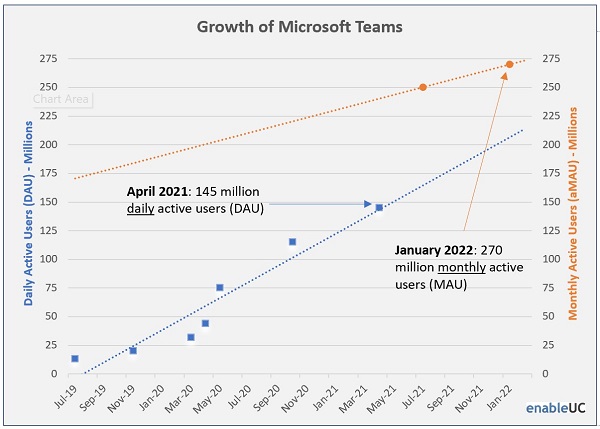A call is a call, whether it involves the PSTN or whether it is internal to an organization or external. I say this upfront because this piece is about how Microsoft defines Teams callers now and how there’s a lot of room for growth.
Recently, Microsoft said it’s got 80 million active Teams phone users. Microsoft is including both VoIP and PSTN calls in its definition of phone users, which is entirely reasonable. With 270 million monthly active users of Teams and given how easy it is for any of these users to make a peer-to-peer call and thus become a “phone user,” 80 million active phone users is realistic.
Unlike some who have suggested Microsoft is exaggerating, I am surprised there are 190 million active Teams users who don’t take advantage of calling capabilities on a regular basis. Given how well Teams calling supports a hybrid work environment, I would expect the number of Teams phone users to grow.
The growth of Microsoft Teams has been exceptional over the past five years (as shown in this graphic).
According to the numbers, Teams surpassed Slack with 13 million daily active users and 19 million weekly active users in
July 2019. Fast forward to January 2022, Microsoft reported 270 million monthly active users of Teams. (We can’t get an apples-to-apples measurement of daily active users because Microsoft shifted its reporting from daily active users to monthly active users in July 2021,
as I’ve covered here. Over 100 organizations have more than 100,000 users of Teams, and almost 3,000 organizations have more than 10,000 Teams users. In spring 2019, when Microsoft reported usage numbers, they had 150 organizations with more than 10,000 Teams users; these latest numbers show a twenty-fold increase in organizations with 10,000 Teams users. Many people in many industries are using Teams for multiple forms of communication and collaboration.
However, when Microsoft stated on its
FY2021 Q4 Earnings call, “We have nearly 80 million monthly active Teams Phone users, with total calls surpassing 1 billion in a single month this quarter, and we’re just getting started," most analysts suggested Microsoft was exaggerating. I don’t think it is.
What is a Phone User?
Let’s make clear how this article defines “Phone User.”
According to Microsoft, “All Microsoft 365 plans allow Teams users to make peer-to-peer calls within your organization using VoIP technology.” Thus, all users are potentially “Phone Users” by virtue that they can make calls by clicking on the Calls icon on the left rail of Teams.
All users can also initiate calls during a 1:1 chat session by clicking on the video or audio call button at the top of the chat window.
These calls can be made between any users within your organization, whether they’re working from home, in the office, or traveling. Calls can be made from a laptop to a mobile phone (running the Teams mobile client), from a mobile phone back to the office, or from one mobile phone to another.
Not All Phone Users are Phone System Users
While all Teams users are potential “phone users” and can make peer-to-peer calls to others within their organization, call users in other organizations (via federation) or make or receive calls to the
PSTN, you require a Phone System License.
Without a Phone System License, if you try to call someone outside your organization—your call is not completed (as shown below).
Also, without a Phone System License, you have no access to a “dial pad” that would enable you to call a specific phone number.
Note that Microsoft is NOT claiming (yet) that 80 million Teams users use Teams as their PBX (to make and receive PSTN calls). Phone Users do not require Phone System Licenses. More importantly, Phone Users are not the same as Phone System Users.
So How many Phone System Licenses are there?
Microsoft does not publish the number of Phone System Licenses sold.
We know a Phone System License is included with every E5 license, and Microsoft has indicated that the “E5 now accounts for 8% of our Office 365 Commercial installed base.” With paid Commercial Office seats reaching nearly 345 million as of April 2022, this means more than 27 million users have a Phone System License via their E5 license.
We also observe that many organizations continue to purchase E3 licenses with the Phone System License add-on (USD 8/user/month).
In total, different estimates suggest between 10% and 20% of active Teams users may be fully enabled for PSTN calling (having both a phone system license and a calling plan), translating to between 27 million and 54 million Teams Phone Users who are fully enabled for PSTN calling.
In Summary
Microsoft has reported having:
- 345 million Commercial Office seats
- 270 million monthly active Teams users (which is 78% of total Commercial Office seats)
- 80 million monthly active Teams Phone Users (which is 30% of total active Teams users)
Based on Microsoft indicating 8% of Commercial Office seats have an E5. That includes a Phone System, License, at least 27 million Teams users have PSTN calling potential, and likely a similar number of users with E3 licenses may have enabled add-on Phone System Licenses.
So, the Teams world currently looks something like the following graphic:
And I expect these circles to expand throughout the year.
This post is written on behalf of BCStrategies, an industry resource for enterprises, vendors, system integrators, and anyone interested in the growing business communications arena. A supplier of objective information on business communications, BCStrategies is supported by an alliance of leading communication industry advisors, analysts, and consultants who have worked in the various segments of the dynamic business communications market.















